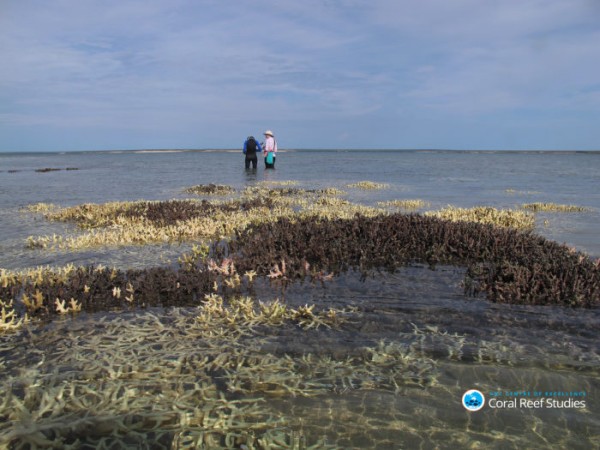More Than 50 Percent of Corals in Northern Great Barrier Reef Now Dead
| Ana Verayo | | May 31, 2016 06:24 AM EDT |
(Photo : Chris Cornwall/ARC Centre of Excellence Coral Reef Studies) Researchers survey bleached corals in shallow water in the Kimberly region, Western Australia, during current bleaching event.
The latest research and underwater surveys reveal how coral bleaching already decimated about 35 percent of corals in the Great Barrier Reef in Australia, specifically in the northern and central parts of the reef, as observed by extensive aerial surveys too.
This confirmation first originated from the Australian Research Council Centre of Excellence for Coral Reef Studies, revealing in this new research the amount of coral that died due to massive bleaching that began early this year.
Like Us on Facebook
This damage extent was presented by current Leader of the Opposition for the Australian Labor Party, Bill Shorten, where it will take about $500 million to provide protection for the reef.
During a coral bleaching event, sea temperatures become abnormally high that can kill tiny marine algae that is crucial for coral reef health.
Past surveys have already shown that 93 percent of the reef have experienced some sort of bleaching at some extent. Scientists say that some coral can recover from this which can depend on the severity of this bleaching, while some cannot.
According to the ARC survey carried out by James Cook University, there are more than 50 percent in the northern region and an average of five percent in the central region of the reef have already died, which indicates that these coral can no longer recover.
According to Terry Hughes from James Cook University, despite bad news there are still some good news on the reef taken from surveys of 100,000 corals from 84 reefs located from Townsville towards Papua New Guinea.
He says that the good news is that there is only light levels of mortality rates from bleaching found on the corals located around Cairns to southern Townsville. This means that only five to 20 percent of coral from those reefs have died.
However, Hughes says that unfortunately in Cairns, 24 of the reefs that have been surveyed is now suffering from a more than 50 percent mortality rate to date. He adds that this type of bleaching is so severe that it does not only kills the coral species that are sensitive to warmer temperatures, but can also kill off stronger corals aged 50 to 100 years old, making this a harder and more challenging recovery for the damaged species in the north.
Shorten already outlined details about the Australian government's plans to monitor and protect the reef in Cairns, and also investing in initiatives to improve water quality and land management.
To date, this is the third mass bleaching event in the Great Barrier Reed in a span of 18 years, where scientists consider this the most extreme one to hit the reef.
Hughes adds that the impact of this bleaching can be estimated by the end of the year, tallying the final death toll at that time. Mildly bleached coral are expected to return to their normal color in the next few months.
TagsGreat Barrier Reef, Cairns, Coral bleaching, massive bleaching event, coral reefs, dead coral reefs, Climate Change, global warming
©2015 Chinatopix All rights reserved. Do not reproduce without permission
EDITOR'S PICKS
-

Did the Trump administration just announce plans for a trade war with ‘hostile’ China and Russia?
-

US Senate passes Taiwan travel bill slammed by China
-

As Yan Sihong’s family grieves, here are other Chinese students who went missing abroad. Some have never been found
-

Beijing blasts Western critics who ‘smear China’ with the term sharp power
-

China Envoy Seeks to Defuse Tensions With U.S. as a Trade War Brews
-

Singapore's Deputy PM Provides Bitcoin Vote of Confidence Amid China's Blanket Bans
-

China warns investors over risks in overseas virtual currency trading
-

Chinese government most trustworthy: survey
-

Kashima Antlers On Course For Back-To-Back Titles
MOST POPULAR
LATEST NEWS
Zhou Yongkang: China's Former Security Chief Sentenced to Life in Prison

China's former Chief of the Ministry of Public Security, Zhou Yongkang, has been given a life sentence after he was found guilty of abusing his office, bribery and deliberately ... Full Article
TRENDING STORY

China Pork Prices Expected to Stabilize As The Supplies Recover

Elephone P9000 Smartphone is now on Sale on Amazon India

There's a Big Chance Cliffhangers Won't Still Be Resolved When Grey's Anatomy Season 13 Returns

Supreme Court Ruled on Samsung vs Apple Dispute for Patent Infringement

Microsoft Surface Pro 5 Rumors and Release Date: What is the Latest?










